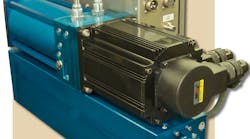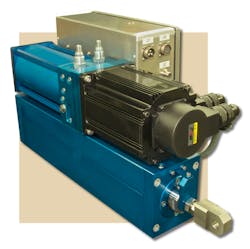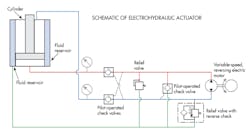Download this article as a .PDF
Today’s global actuation market is worth in excess of $30 billion, and is projected to continue growing as automation becomes the focus of increased production throughout the developing world. The majority of actuators used today provide simple linear motion for moving objects from one point to another. The need for advanced actuation increases along with the development of more sophisticated equipment.
Trends in automation to increase productivity are the driving factors for continued actuation growth and development. Yet, actuation enhancements are progressing at only a modest pace, presenting a challenge to keep up with the current and future market trends. Some of the factors include the need for less maintenance, higher efficiency, advanced connectivity (field buses), lower weight, and compact actuation solutions.
The three major types of actuation technology are electro-mechanical, hydraulic, and pneumatic. Each, of course, has its advantages and disadvantages.
The Electromechanical Solution
The electromechanical actuator (EMA) accounts for about 46% of the economic market. Furthermore, it is growing faster than hydraulics and pneumatics technologies, produces power on demand, and is more efficient than systems that run continuously to maintain pressure. There are many different methods for converting the rotary motion of the motor into linear motion of the rod.
Many EMAs use a motor connected to a gear-train or a belt drive to reduce output speed while increasing torque. An output nut then converts the rotary motion to linear motion, usually through an ACME screw or ball screw. In other cases, the motor is connected directly to a roller screw. Directly coupling the motor provides absolute position control via a position feedback sensor. Whichever drive setup is used to provide linear motion, the EMA operates from any ac or dc power.
A simple ac or dc system turns the motor on and off and rotates it at the given motor winding speed based on the applied voltage. The actuator transitions between extreme positions set via limit switches with no other position control. AC solutions can use a stepper motor, brushless servomotor, or ac induction motor with or without closed-loop control. More sophisticated ac and dc systems control position using a controller that varies motor output based on a signal from the position feedback sensor. Along with position control, the controller can also provide a fieldbus interface to connect and interact with other actuators, so as to synchronize multi-axial motion and provide control data transmission and diagnostics to a master PLC.
Of course, with these benefits come disadvantages inherent to electromechanical actuators. Because the motor is mechanically coupled to the output shaft, backlash occurs and worsens over time. Most EMAs can be back-driven, meaning the load can drive the output shaft backwards when the drive is not powered. For this reason, most EMAs require a brake to hold the load in position when the drive is at rest. Because the EMA is driven by an electric motor, exceeding rated duty cycles will cause overheating. In fact, most EMAs are specified with a duty cycle to allow heat to dissipate between work periods.
Electromechanical actuators are also unforgiving to modification. For example, if drive parameters must be changed to provide greater speed or force, the entire EMA generally must be replaced. Sometimes a gear ratio or can be changed, but doing so reduces either output force or speed. EMAs with a lead screw are also susceptible to contamination, leading to premature wear. Depending on many variables, the efficiency of an EMA (converting input electrical power to output mechanical power) generally ranges from 20% to 40%. The majority of the offerings available today require a customer to specify and setup their own motor and controller to connect to the desired actuator.
The Hydraulic Solution
The traditional central hydraulic system is about 30% of the actuation market and provides unmatched power in a compact package. Hydraulic is viewed as having an extremely high power density: the ability to transmit more power form a smaller and lighter actuator than any other common form of power transmission. And the greater the power, the greater advantage of hydraulics. Because output force of a hydraulic cylinder is based on fluid pressure and cylinder bore, at a constant pressure, increasing cylinder bore by only 30% increases output force by nearly 70% while pressure remains constant.
Another big advantage to hydraulics is that the direction of travel can be reversed rapidly and repeatedly simply by shifting a valve. Furthermore, rapid cycling can be performed without the need for frequent dwell periods to prevent overheating. Instead, any heat that builds up in a hydraulic system can be conveyed by the hydraulic fluid to a central heat exchanger in the hydraulic power unit. Not requiring a load-holding brake is another advantage of hydraulics. Pilot-operated check valves or counterbalance valves are usually all that are required to hold a load in place with no power to the hydraulic system.
Hydraulic systems can also accurately and easily provide closed-loop control of output force simply by incorporating a pressure transducer and a pressure-control valve with an electronic controller. Closed-loop position control can be accomplished by integrating a linear transducer with the cylinder to provide position feedback through an electrohydraulic proportional or servovalve.
Most of us are familiar with the disadvantages of hydraulic systems. Conventional systems, which use a pump that operates continuously, are inefficient. Hydraulic systems also consist of a network of hoses and fitting that must be maintained to prevent leakage. A variety of filters much be changed regularly, and fluid cleanliness should be checked regularly to provide preventive maintenance against premature component failure from contamination. Providing accurate and coordinated position control with field bus integration can be challenging and expensive compared to an EMA solution.
Pneumatic systems make up the remaining 24% of the market. They provide a safe, clean, and reliable method of actuation simply by tapping into a plant’s compressed air system, which typically operates at pressures from 80 to 100 psi. Today’s automated plants contain thousands of air cylinders that move rapidly from point A to point B. Although proportional pneumatic systems continue to be used in some applications—especially where the cushioning effects of compressed air is an advantage—most industrial pneumatic systems use simple discrete (“bang-bang”) valves that direct cylinders back and forth thousands of times a day.
Pneumatic systems have some of the same drawbacks as hydraulics. Probably the most significant disadvantage of pneumatics is energy usage. Energy is used to transmit power through controls, through and electric motor, and throughout the pneumatic system. Leaks may not cause oil to accumulate on and around the system, but they do represent wasted energy. Pneumatic systems also require periodic maintenance for changing filters and fixing leaks. And because pneumatic systems generally operate at pressures much lower than those used with hydraulics, pneumatic actuators are usually large than their hydraulic counterparts.
The Trend Continues
As with any technology that has been around for 80 years, you might think most major advances have already occurred and only expect slight enhancements to occur. However, a fourth technology—electrohydraulic actuation (EHA)—has been emerging that combines most of the advantages of hydraulics with electromechanical actuators, without many of the disadvantages.
An electrohydraulic actuator integrates a hydraulic cylinder with a controller, motor, pump, reservoir, and control manifold into a self-contained solution. An EHA may not seem all that new, but Kyntronics combines a drive, servomotor, manifold, and cylinder within a self-contained package. A key element of the Kyntronics EHA is a rod-volume compensating mechanism, which compensates for the differential volume between the cylinder’s rod- and cap-end volumes as the piston rod extends and contracts. The rod-volume compensator uses closed cell foam wrapped around the inner pressure cylinder.
The modular system starts with a bidirectional ac or dc servomotor driving a gear pump. This eliminates the need for a proportional directional valve because the motor controls flow rate and direction. A big advantage over conventional hydraulic solutions is energy efficiency. That’s because when no pressure or flow is needed, the motor consumes no energy. And when holding force with no motion is required, the motor maintains torque to hold pressure.
These general features make EHA technology attractive, but one beneficial feature of the Kyntronics EHA is the way the differential volume is accounted for between a cylinder’s cap and rod ends. For example, when the pump routes fluid into the cap end of the cylinder to extend the piston rod, fluid flows from the cap end at a lower rate. Likewise, when the pump routes fluid into the rod end to retract the piston rod, fluid flows at a higher rate from the cap end.
To compensate for this difference in volume, the hydraulic cylinder includes an outer low-pressure cylinder, which creates a chamber between the two cylinders. This chamber contains compressible foam to serve the same purpose as an accumulator in conventional systems. The foam, however, does not require an initial precharge, nor does it require any maintenance.
The Kyntronics solution provides power on demand and delivers the most efficient (50% to 80%) method of converting electrical power to mechanical power. Overall efficiency using a combination of hydraulic and electrics far exceed that of the other individual methods discussed here. A smaller motor can be used for similar loads compared to using an EMA. Doing so reduces size, weight, and overall costs. This solution can be oriented in any position and eliminates the hoses and potential leaks.
Other Design Features
Those familiar with hydraulics may question how heat generation is managed in a hydraulic system that has no external heat exchanger. The system uses proven design practices for low heat generation, such as large port openings, as few right-angle bends as possible, and taking advantage of surface areas to transfer heat to the surrounding area. Extensive tests and field installations have proven that operating temperatures stabilize well within the specifications of the oil.
The cylinder includes integrated position and pressure feedback sensors for closed-loop motion and force control. The EHA solution accepts multiple ac and dc voltages and easily connects to popular fieldbus systems (CAN, Ethernet, etc.). The EHA can withstand high shock loads and does not require a brake to hold position. Its modular design allows assembling the EHA to individual application specifications, thus reducing lead time over custom solutions.
The unit’s drive controller can be pre-configured to reduce setup time and eliminate programming. However, software is available to setup or change desired indexes as needed. One can easily select a position controlled index, set up the speeds or desired forces, and connect up the actuator, and then it’s ready to go. The Kyntronics EHA accommodates loads to 24,000 lbf, speeds to 20 in./sec, and strokes to 78 in. or longer from ac or dc power.
Carl Richter is vice president at Kyntronics Inc., Eastlake, Ohio. For more information on the Kyntronics electrohydraulic actuator, call (440) 220-5590, or visit the company's website.




